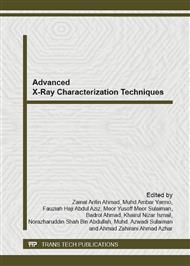p.208
p.213
p.219
p.224
p.230
p.236
p.241
p.246
p.252
Investigation of Grain Size Effect on the Impedance of CaCu3Ti4O12 from 100 Hz to 1 GHz of Frequency
Abstract:
CaCu3Ti4O12 (CCTO) is a cubical perovskite phase and sintered ceramics exhibit very high dielectric constant at room temperature. The speculated origins of the high dielectric constant are the existence of insulative barrier layer at grain boundaries and domain boundaries which created an internal barrier layer capacitance (IBLC) at the microstructure of CCTO. The relation of grains and domains electrical resistance were studied in this work by using impedance spectroscopy (IS). A series of samples with different heat treatment temperature were tested to investigate their microstructure by using field emission scanning electron microscopy (FESEM). The grains and domains resistance was calculated from a wide frequency range of impedance complex plane measurement (100 Hz to 1 GHz). The FESEM and IS analyses showed the dependency of grains and domains resistance to average grains size of CCTO microstructure.
Info:
Periodical:
Pages:
230-235
Citation:
Online since:
December 2012
Keywords:
Price:
Сopyright:
© 2013 Trans Tech Publications Ltd. All Rights Reserved
Share:
Citation:


